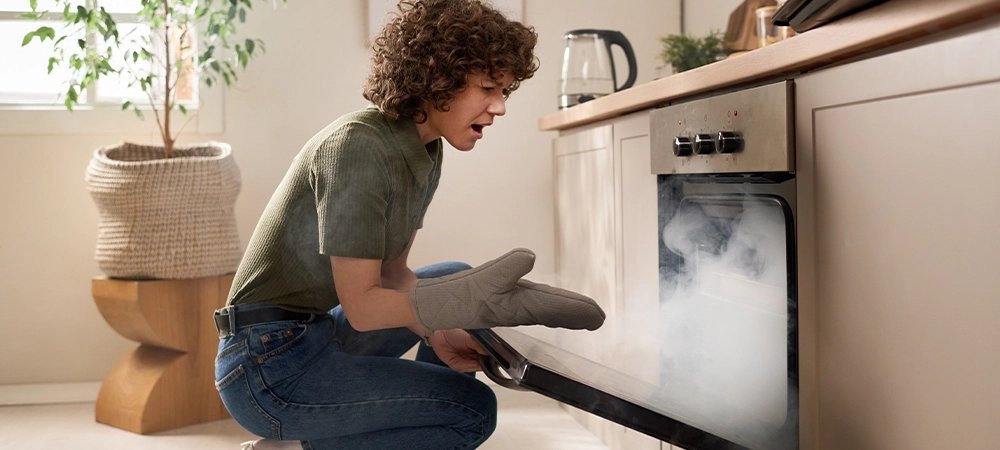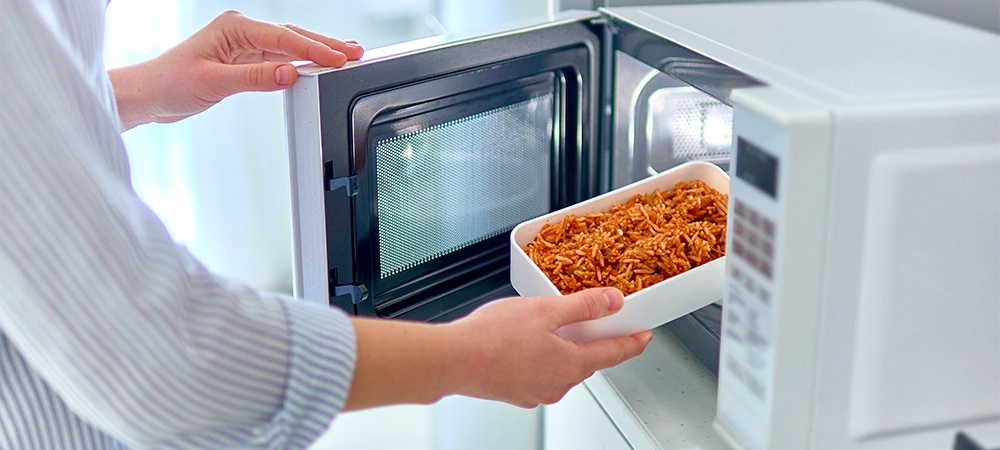We’ve all been there. You heat last night’s leftovers in the microwave, open the door, and are greeted by a foggy window, tiny water droplets clinging to the interior. It’s a familiar sight, yet it can still raise questions: Is this normal? Is my microwave malfunctioning? Should I be worried?
Rest assured, a certain amount of condensation in your microwave is perfectly normal. It’s simply a byproduct of the heating process, as steam from your food cools and condenses on the cooler surfaces inside the appliance.
However, there’s a difference between normal condensation and excessive or persistent moisture buildup. While light fogging is usually harmless, an overly damp microwave could indicate a problem that needs attention. This could range from a minor issue like a worn-out door seal to a more significant malfunction requiring professional repair.
At Prime Appliance Repairs, we understand the inner workings of your microwave and can help you determine whether the condensation you’re seeing is a cause for concern.
In this guide, we’ll break down the science behind microwave condensation, explain what’s normal and not, and provide practical tips for keeping your appliance running smoothly.
Why Does My Microwave Collect Condensation?
The science behind microwave condensation is surprisingly simple. As your food heats up, the water molecules within it gain energy and move faster, transforming into water vapour or steam.
This steam rises and encounters the cooler surfaces of the microwave interior—the walls, ceiling, and even the door. When the steam comes into contact with these cooler surfaces, it loses energy and cools down, turning back into liquid water. This is the condensation you see fogging up your microwave window.
So, how much condensation is considered normal? A light misting or a few droplets on the interior surfaces after heating food is typical. This is especially true when heating foods with high moisture content, such as soups, sauces, or vegetables.
Related Article: How Do You Fix a Microwave F6?
When Condensation Could Signal a Problem
While a bit of condensation is par for the course, a consistently damp microwave could be a sign that something’s amiss. Here are a few common culprits to watch out for:
Door Seal Issues
The door seal is a rubber gasket that runs inside the microwave door. It creates an airtight seal, preventing steam from escaping during cooking. Over time, this seal can become worn, cracked, or damaged, allowing steam to leak out. This leads to excessive condensation, reducing the microwave’s efficiency and posing a safety risk.
Look closely at the door seal if you notice your microwave steaming excessively. Check for any signs of wear, such as cracks, tears, or gaps. If you see any damage, it’s time to replace the seal to restore your microwave’s performance and safety.
Vent Blockage
Microwaves have vents that allow steam and heat to escape during operation. If these vents become clogged with food particles, grease, or dust, moisture can get trapped inside the microwave, leading to condensation buildup. This affects the appliance’s performance and can lead to overheating, which could damage internal components.
To prevent vent blockage, clean your microwave regularly, paying particular attention to the vent area. If you suspect a blockage, gently clean the vents with a soft brush or cloth. Calling a professional to clean or repair the ventilation system safely is best if the issue persists.
Related Article: My Oven Door Seals Leak a Lot of Heat. Can I Fix It?
Other Potential Causes
While less common, other factors could also contribute to excessive condensation in your microwave. These include:
Faulty Magnetron: The magnetron is the component that generates the microwaves used to heat your food. Malfunctioning could cause uneven heating and lead to excess moisture buildup.
Damaged Wave Guide Cover: The waveguide cover helps direct the microwaves inside the oven. If it’s damaged, it could allow microwaves to leak out, affecting heating performance and contributing to condensation.
These issues typically require professional diagnosis and repair. If you suspect a more serious problem with your microwave, it’s best to contact a qualified technician to assess the situation and recommend the appropriate solution.
Troubleshooting & Prevention Tips
Let’s explore some simple troubleshooting and prevention tips to keep your appliance dry and functioning optimally.
Ventilate: After heating food, especially dishes with high moisture content, leave the microwave door open for a few minutes. This allows the steam to escape and the interior to air out, reducing condensation buildup.
Wipe It Down: Make it a habit to wipe down the interior of your microwave after each use with a clean, dry cloth or paper towel. This will remove any lingering moisture and prevent it from accumulating over time. A damp cloth with a mild detergent can be used for tougher grime, followed by a dry wipe.
Cover Food: Whenever possible, cover your food with a microwave-safe lid, plate, or paper towel. This helps trap the steam during cooking, minimizing the moisture that escapes into the microwave interior.
Check the Door Seal: Inspect the door seal regularly for any signs of wear and tear, such as cracks, gaps, or warping. A damaged seal can allow steam to escape, leading to excessive condensation and potentially compromising the microwave’s heating efficiency.
These simple steps can significantly reduce condensation in your microwave and ensure its longevity and optimal performance. A little care and attention go a long way in maintaining your appliances and preventing unnecessary repairs.
When to Call a Professional
If you’ve tried the troubleshooting tips above and are still dealing with excessive condensation, it’s time to call the experts. Persistent moisture buildup could indicate a deeper issue that requires professional diagnosis and repair.
Red Flags
Besides excessive condensation, here are some additional signs that your microwave might need professional attention:
Unusual Noises
If your microwave makes buzzing, grinding, or popping sounds during operation, it could be a sign of a malfunctioning magnetron or other internal component.
Burning Smells
A burning odour emanating from your microwave is never a good sign. It could indicate that food particles or grease have accumulated and are burning, or it could signal a more serious electrical problem.
Poor Heating Performance
If your food isn’t heating up properly or takes much longer than usual, it could indicate a problem with the magnetron, diode, or other components.
Related Article: How to Repair an LG Microwave Oven Not Heating: A Step-by-Step Guide
Prime Appliance Repairs: Your Microwave Experts
At Prime Appliance Repairs, we have the expertise and experience to diagnose and repair various microwave issues. We will thoroughly assess your appliance, identify the root cause of the problem, and provide practical solutions to get your microwave back in working order.
We offer prompt service, competitive rates, and a 6-month warranty on all repairs for your peace of mind.
Keep Calm and Microwave On
Microwave condensation is common, and light fogging after heating food is usually nothing to worry about. However, excessive or persistent condensation could indicate an underlying issue that needs attention.
Following our troubleshooting tips and knowing when to call a professional, you can keep your microwave running smoothly and safely.
If you have any concerns about your microwave’s performance or notice any unusual symptoms, please contact Prime Appliance Repairs. We’re here to help you keep your appliances in top shape.










